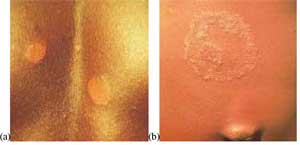Self-Assessment Questions (SAQs) for Study Session 18
Now that you have completed this study session, you can assess how well you have achieved its Learning Outcomes by answering these questions. Write your answers in your Study Diary and discuss them with your Tutor at the next Study Support Meeting. You can check your answers with the Notes on the Self-Assessment Questions at the end of this Module.
SAQ 18.1 (tests Learning Outcome 18.4)
Look at the skin lesions in Figure 18.13(a) and (b). Identify, with reasons, which one shows the signs of leprosy. Keep in mind that in Figure 18.13(a) there is loss of sensation, but no loss of sensation or nerve enlargement in Figure 18.13(b).
Answer
Figure 18.13(a) is a photo from a leprosy patient, because it shows a skin lesion with accompanying loss of sensation. If you are told there is no loss of sensation or signs of nerve enlargement (Figure 18.13b) you should not suspect leprosy.
SAQ 18.2 (tests Learning Outcome 18.2)
Is it right to say that leprosy has been eliminated in Ethiopia and that as a Health Extension Practitioner you therefore don’t need to be looking out for cases of the disease?
Answer
Leprosy is understood to be eliminated in countries where fewer than 1 case for every 10,000 population is identified; the rate in Ethiopia is 0.57 cases per 10,000 population, so it has been eliminated in Ethiopia. However, this does not mean there are never any cases. So, as a HEP, you need always to be looking out for leprosy suspects to help reduce the incidence in Ethiopia even further.
SAQ 18.3 (tests Learning Outcomes 18.1 and 18.3)
Which of the following statements is false? In each case, explain what is incorrect.
A The inside lining of the nose and the skin are major portals of entry of leprosy bacteria.
B MDT has not proved successful in the fight against leprosy.
C MDT treatment helps nerves and organs damaged as a result of leprosy to start functioning again normally.
D If leprosy is untreated, organs such as the eyes can become damaged and fingers and toes can be lost.
E Case finding is essential to the task of reducing the prevalence of leprosy.
F Case finding involves only the process of carefully looking at individuals attending your health facility for signs of leprosy.
Answer
A is true: as you will have learned early in Section 18.3.
B is false: MDT has resulted in the elimination of leprosy in many countries.
C is false: MDT can stop the progress of the disease, but it cannot restore damaged nerves.
D is true: as you see in Figure 18.1.
E is true: case finding is a very important way of reducing the incidence of the disease.
F is false: this is only one part of case finding. Also involved (Section 18.3.1) is active case finding, where contacts of those with leprosy are examined.
SAQ 18.4 (tests Learning Outcome 18.4)
- a.Someone at your health facility presents to you with weakness of both hands. Should you suspect he has leprosy or not? What should you do to confirm your suspicion?
- b.Another individual explains to you that she has some areas of skin that are sore and that are very itchy. When you test her, she has normal responses to VMT. Do you suspect leprosy or not?
Answer
- a.You should suspect leprosy because weakness of the hands is a sign of leprosy. You should take his history according to the guidelines in Box 18.2 and examine any skin patch for loss of sensation. In addition, you should do sensitivity tests (ST) and voluntary muscle tests (VMT) on both wrists.
- b.Skin signs such as these do not suggest leprosy and the fact that the patient’s responses to VMT are normal is further evidence that the disease is not present.
Summary of Study Session 18

